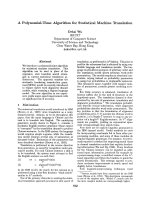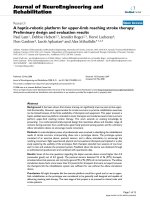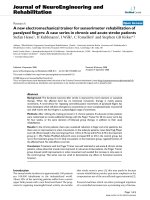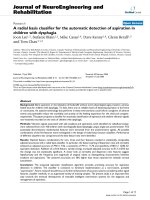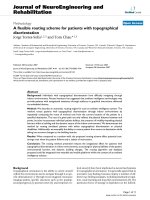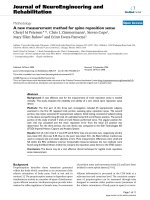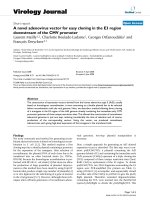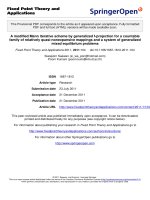Báo cáo hóa học: " A projective splitting algorithm for solving generalized mixed variational inequalities" doc
Bạn đang xem bản rút gọn của tài liệu. Xem và tải ngay bản đầy đủ của tài liệu tại đây (314.56 KB, 14 trang )
RESEARC H Open Access
A projective splitting algorithm for solving
generalized mixed variational inequalities
Fu-quan Xia
1*
and Yun-zhi Zou
2
* Correspondence: fuquanxia@sina.
com
1
Department of Mathematics,
Sichuan Normal University,
Chengdu, Sichuan 610066, P. R.
China
Full list of author information is
available at the end of the article
Abstract
In this paper, a projective splitting method for solving a class of generalized mixed
variational inequalities is considered in Hilbert spaces. We investigate a general
iterative algorithm, which consists of a splitting proximal point step followed by a
suitable orthogonal projection onto a hyperplane. Moreover, in our splitting
algorithm, we only use the individual resolvent mapping (I + μ
k
∂f)
-1
and never work
directly with the operator T +∂f, where μ
k
is a positive real number, T is a set-valued
mapping and ∂f is the sub-differential of function f. We also prove the convergence
of the algorithm for the case that T is a pseudomonotone set-valued mapping and f
is a non-smooth convex function.
2000 Mathematics Subject Classification: 90C25; 49D45; 49D37.
Keywords: projective splitting method, generalized mixed variational inequality,
pseudomonotonicity
1 Introduction
Let X be a nonempty closed convex subset of a real Hilbert space H, T : X ® 2
H
be a
set-valued mapping and f : H ® (- ∞,+∞] be a lower semi-continuous (l.s.c) proper
convex function. We consider a generalized mixed variational inequality problem
(GMVIP): find x* Î X such that there exists w* Î T(x*) satisfying
w
∗
, y − x
∗
+ f
(
y
)
− f
(
x
∗
)
≥ 0, ∀y ∈ X
.
(1:1)
The GMVIP (1.1) has enormous applications in many areas such as mechanics, opti-
mization, equilibrium, etc. For details, we refer to [1-3] and the references therein. It
has therefore been widely studies by many authors recently. For example, by Rockafel-
lar [4], Tseng [5], Xia and Huang [6] and the special case (f = 0) was studied by Crou-
zeix [7], Danniilidis and Hadjisavvas [8] and Yao [9].
A large variety of problems are special instances of the problem (1.1). For example, if
T is t he sub-differential of a finit e-valued convex continuous function defined on
Hilbert space H, then the problem (1.1) reduces to the following non-differentiable
convex optimization problem:
min
x∈X
{f
(
x
)
+ ϕ
(
x
)
}
.
Furthermore, if T is single-valued and f = 0, then the problem (1.1) reduces to the
following classical variational inequality problem: find x* Î X such that, for all y Î X,
Xia and Zou Journal of Inequalities and Applications 2011, 2011:27
/>© 2011 Xia and Zou; licensee Springe r. This is an Open Access article distributed under the terms of the Creative Commons At tribution
License ( which permits unrestricted use, distribution, and reproduction in any medium,
provided the original work is properly cited.
T
(
x
∗
)
, y − x
∗
≥0
.
(1:2)
Many methods have been proposed to solve classical variational inequalities (1.2) in
finite and infinite dimensional spaces. The simple one among these is the projection
method which has been intensively studied by many authors (see, e.g., [10-14]). How-
ever, the classical projection method does not work for solving the GMVIP (1.1). There-
fore, it is worth studying other implementable methods for solving the problem (1.1).
Algorithms that can be applied for solving the problem (1.1) or one of its variants
areverynumerous.ForthecasewhenT is maximal monotone, the most famous
method is the pr oximal method (see, e.g., Rockafellar [4]). Splitt ing methods have also
been studied to s olve the problem (1.1). Here, the set-valued mapping T and ∂(f+ψ
X
)
play separate roles, where ψ
X
denot es the indicat or function associated with X (i.e., ψ
X
(x)=0ifx Î X and +∞ otherwise) and ∂(f + ψ
X
) denotes the sub-differential of the
convex function f + ψ
X
. The simplest splitting method is the forward-backward scheme
(see, e.g., Tseng [5]), in which the iteration is given by
x
k+1
∈ [I + μ
k
∂
(
f + ψ
X
)
]
−1
[I − μ
k
T]
(
x
k
),
(1:3)
where {μ
k
} is a sequence of positive real numbers. Cohen [15] developed a general
algorithm framework for solving the problem (1.1) in Hilbert space H,basedonthe
so-called auxiliary problem principle. The corresponding method is a generalization of
the forward-backward method. Due to the auxiliary problem principle Cohen [15],
Salmon et al. [16] developed a bundle method for solving the problem (1.1).
For solving the GMVIP (1.1), some authors assumed that T is upper semi-continuous
and mono-tone(o r some other stronger conditions, e.g., strictly monotone, paramono-
tone, maximal monotone, strongly monotone). Moreo ver, their methods fail to provide
convergence under weaker conditions than the monotonicity of T. So, it is a significant
work that how to solve the problem (1.1) when T fails to be monotone. This is one of
the main motivations of this paper.
On the other hand, the GMVIP (1.1) can be expressed as an inclusion form as
follows: find x* Î X such that
0 ∈ T
(
x
∗
)
+ ∂
(
f + ψ
X
)(
x
∗
).
Thus, the problem (1.1) is a special case of the following inclusion problem:
0 ∈ A
(
x
)
+ B
(
x
),
(1:4)
where A and B are set-valued operators on real Hilbert space H.
The algorithms for solving the inclusion (1.4) have an extensive literature. The sim-
ples t one among these is the splitting m ethod. All sp litting methods can be essentially
divided into three classes: Douglas/Peaceman-Rachford class (see, e.g., [17,18]), the
double-backward class ( see, e.g., [19]), and the forward-backward class (see, e.g.,
[20,21] ). Therefore, one natural pro blem is whether the splitting method can be devel-
oped for solving (1.1). This is another main motivation of this paper.
In this paper, we provide a pro jective splitting method fo r solving t he GMVIP (1.1)
in Hilbert spaces. Our iterative algorithm consists of two steps. The first step of the
algorithm in generating a hyperplane separating z
k
from the solution set of problem
(1.1). The second step is th en to project z
k
onto this hyperplane (with some relaxation
Xia and Zou Journal of Inequalities and Applications 2011, 2011:27
/>Page 2 of 14
factor). We first prove that the sequences {x
k
}and{z
k
} are weakly convergent. We also
prove that the weak limit point of {x
k
} is the same as the weak limit point of {z
k
}.
Moreover, we obtain that the weak limit point of these sequences is a solution of the
problem (1.1) under the conditions that the set-valued mapping T is pseudomonotone
with respect to f and the function f is convex.
2 Preliminaries
For a convex function f : H ® (-∞,+∞], let domf ={x Î H : f(x) <∞}denoteitseffec-
tive domain, and let
∂f
(
·
)
= {p ∈ H : f
(
y
)
≥ f
(
·
)
+ p, y −·, ∀y ∈ H
}
denote its sub-differential.
Suppose that X ⊂ H is a nonempty closed convex subset and
dist
(
z, X
)
:= inf
x∈X
||z − x|
|
is the distance from z to X. Let P
X
[z] denote the projection of z onto X, that is, P
X
[z]
satisfies the condition
|
|z − P
X
[z]|| =dist
(
z, X
).
The follow ing well-known properties of the projection operator will be used later in
this paper.
Proposition 2.1. [22] Let X be a nonempty closed co nvex subset in H, the following
properties hold:
(i) 〈x - y, x - P
X
[x]〉 ≥ 0, for all x Î H and y Î X;
(ii) 〈P
X
[x]-x, y - P
X
[x]〉 ≥ 0, for all x Î H and y Î X;
(iii) ||P
X
[x]-P
X
[y]|| ≤ ||x - y||, for all x, y Î H.
Definition 2.1.LetX be a nonempty subset of a Hilbert space H,andletf : X ®
(-∞,+∞] a function. A set-valued mapping T : X ® 2
H
is said to be
(i) monotone if
u − v, x − y≥0, ∀x, y ∈ X, u ∈ T
(
x
)
, v ∈ T
(
y
);
(ii) pseudomonotone with respect to f if for any x, y Î X, u Î T(x), v Î T(y),
u, y − x + f
(
y
)
− f
(
x
)
≥ 0 ⇒v, y − x + f
(
y
)
− f
(
x
)
≥ 0
.
We will use the following Lemmas.
Lemma 2.1.[23]LetD be a nonempty convex set of a topolo gical vector space E
and let j : D × D ® ℝ∪{+∞} be a function such that
(i) for each v Î D, u ® j(v, u) is upper semi-c ontinuous on each nonempty com-
pact subset of D;
(ii) for each nonempty finite set {v
1
,···,v
m
} ⊂ D and for each
u
=
m
i=1
λ
i
v
i
(λ
i
≥ 0,
m
i
=1
λ
i
=1
)
, max
1≤i≤m
j(v
i
, u) ≥ 0;
Xia and Zou Journal of Inequalities and Applications 2011, 2011:27
/>Page 3 of 14
(iii) there exists a nonempty compact convex s ubset D
0
of D and a nonempty
compa ct subset K of D such that, for each u Î D\K, there is v Î co (D
0
∪ { u}) with
j(v, u) <0.
Then, there exists
ˆ
u ∈ K
such that
φ
(
v,
ˆ
u
)
≥ 0
for all v Î D.
Lemma 2.2.[24,p.119]LetX, Y be two topological spaces, W : X × Y ® ℝ be an
upper semi-continuous function , and G : X ® 2
Y
be uppe r semi-continuous at x
0
such
that G(x
0
) is compact. Then, the marginal function V defined on X by
V
(x)= sup
y∈G
(
x
)
W(x, y
)
is upper semi-continuous at x
0
.
Lemma 2.3.[25]Lets Î [0, 1) and
μ =
1 − (1 − σ
2
)
2
.Ifv = u+ξ,where||ξ||
2
≤
s
2
(||u||
2
+||v||
2
), then
(i) 〈u, v〉 ≥ (||u||
2
+||v||
2
)(1 - s
2
)/2;
(ii) (1 - μ)||v|| ≤ (1 - s
2
)||u|| ≤ (1 + μ)||v||.
3 Projective splitting method
ψ
X
: H ® (- ∞,+∞] be the indicator function associated with X. Cho ose three positive
sequences {l
k
>0}, {a
k
} Î (0, 2) and {r
k
} Î (0, 2). Select a fixed relative error tolerance
s Î [0, 1) . We first describe a new projective splitting algorithm for t he GMVIP (1.1),
and then give some preliminary results on the algorithm.
Algorithm 3.1.
Step 0. (Initiation) Select initial z
0
Î X. Set k =0.
Step 1. (Splitting proximal step) Find x
k
Î X such that
x
k
+ λ
k
g
k
= z
k
+ λ
k
ξ
k
, g
k
∈ ∂[f + ψ
X
]
(
x
k
)
(3:5)
x
k
− λ
k
w
k
=
(
1 − α
k
)
z
k
+ α
k
x
k
− λ
k
ξ
k
, w
k
∈ T
(
x
k
)
(3:6)
where the residue ξ
k
Î H is required to satisfy the following condition:
||ξ
k
|| ≤ σ
α
2
k
||z
k
− x
k
||
2
/(4λ
2
k
)+||g
k
+ w
k
||
2
/4
.
(3:7)
Step 2. (Projection step) If g
k
+ w
k
= 0, then STOP; otherwise, take
¯z
k
= z
k
− β
k
(
g
k
+ w
k
)
with β
k
= g
k
+ w
k
, z
k
− x
k
/||g
k
+ w
k
||
2
.
(3:8)
Step 3. Set
z
k+1
= z
k
+ ρ
k
(
¯z
k
− z
k
)
.
Step 4. Let k = k + 1 and return to Step 1.
In this paper, we focus our attention on obtaining general conditions ensuring the
convergence of {z
k
}
kÎN
and {x
k
}
kÎN
toward a solution of problem (1.1), under the fol-
lowing hypotheses on the parameters:
λ
1
:= inf
k≥0
λ
k
> 0, λ
2
:= sup
k
≥
0
λ
k
< ∞
,
(3:9)
Xia and Zou Journal of Inequalities and Applications 2011, 2011:27
/>Page 4 of 14
R
1
:= in
f
k≥0
ρ
k
> 0andR
2
:= sup
k
≥
0
ρ
k
< 2
,
(3:10)
To motivate Algorithm 3.1, we note that (3. 1) implies x
k
=(I + l
k
∂f)
-1
(z
k
+ l
k
ξ
k
),
and that the operator (I + l
k
∂f)
-1
is everywhere defined and single-valued. Rearran-
ging (3.1) and (3.2), one has
g
k
= ξ
k
+
z
k
−x
k
λ
k
and
w
k
=
1−α
k
λ
k
(x
k
− z
k
)+ξ
k
.Algorithm3.1
is a true splitting method for problem (1.1), in that it only uses the individual resol-
vent mapping (I + l
k
∂f)
-1
, and never works d irectly with the operator ∂f + T.The
existence of x
k
Î X and w
k
Î T(x
k
) such that (3.1)-(3.2) will be proved in the follow-
ing Theorem 3.1.
Substituting (3.1) into (3.2) and simplifying, we obtain
α
k
(x
k
− z
k
)
λ
k
+ g
k
+ w
k
=2ξ
k
.
(3:11)
This method is the so-called inexact hybrid proximal algorithm for solving problem
(1.1). Obvious that problem (3.7) is solved only approxima tely and t he residue ξ
k
Î H
sati sfying (3.3). There are at least two reasons for dealing with the proximal algorithm
(3.7). First, it is generally impossible to find an exact value for x
k
given by (3.1) and
(3.2). Particularly when T is nonlinear; second , it is clearly inefficient to spe nd too
much effort on the computation of a given iterate z
k
when only the limit of the
sequence {x
k
} has the desired properties.
It is easy to see that (3.4) is a projection step because it can be written as
¯
z
k
= P
K
(
z
k
)
,
where P
K
: H ® K is the ortho gonal projection operator onto the half-space K ={z Î
H : 〈g
k
+ w
k
, z - x
k
〉 ≤ 0}. In fact, by (3.4) we have
¯
z
k
= z
k
− β
k
(
g
k
+ w
k
)
. Then for each
y Î K, we deduce that
z
k
−¯z
k
, y − z
k
= β
k
g
k
+ w
k
, y − z
k
= β
k
g
k
+ w
k
, y − x
k
+ β
k
g
k
+ w
k
, x
k
− z
k
= β
k
g
k
+ w
k
, x
k
− z
k
(since g
k
+ w
k
, y − x
k
≤0
)
≤ 0
(
since β
k
= g
k
+ w
k
, z
k
− x
k
/||g
k
+ w
k
||
2
)
.
By Proposition 2.1, we know that
¯
z
k
= P
K
(
z
k
)
. By pseudomon otonicity o f T with
respect to f and Theorem 4.1(ii) below, the hype rplane K separates the current iterate z
k
from the set S ={x Î H :0Î ∂f(x)+T(x)}. Thus, in Algorithm 3.1, the splitting proximal
iteration is used to c onstruct this separation hyperplane, the next iterate z
k+1
is then
obtained by a trivial projection of z
k
, which is not expensive at all from a numerical
point of view.
Now, we will prove that the sequence {x
k
} is well defined and so is the sequence {z
k
}.
Note that if x
k
satisfies (3.1)-(3.2) together with (3.3), with s =0,thenx
k
always satisfies
these conditions with any s Î [0, 1). Since s = 0 also implies t hat the error term ξ
k
vanishes, existence of x
k
for ξ
k
= 0 is enough to ensure the existence of ξ
k
≠ 0. So in the
following theorem 3.1, we assume that ξ
k
=0.
Theorem 3.1.LetX be a nonempty closed convex subset of a Hilbert space H,and
let f : X ® (- ∞,+∞]beal.s.cproperconvexfunction.AssumethatT : X ® 2
H
is
pseudomonotone with respect to f and upper semi-contin uous from the weak topology
to the weak topology with w eakly compact convex values. If the parameter a
k
, l
k
>0
Xia and Zou Journal of Inequalities and Applications 2011, 2011:27
/>Page 5 of 14
and solution set of proble m (1.1) is nonempty, then for each given z
k
Î X,thereexist
x
k
Î X and w
k
Î T(x
k
) satisfying (3.1)-(3.2).
Proof. For each given z
k
Î X and ξ
k
= 0, it follows from (3.1) and (3.2) that,
g
k
=
1
λ
k
[α
k
(z
k
− x
k
) − λ
k
w
k
]
,
(3:12)
where g
k
Î ∂[f + ψ
X
](x
k
) and w
k
Î T (x
k
). (3.8) is equivalent to the following inequal-
ity:
α
k
λ
−1
k
x
k
− z
k
, y − x
k
+ w
k
, y − x
k
+ f (y) − f (x
k
) ≥ 0, ∀y ∈ X
.
So we consider the following variational inequality problem: find x
k
Î X such that
for each y Î X,
α
k
λ
−
1
k
x
k
− z
k
, y − x
k
+sup
w
k
∈T
(
x
k
)
w
k
, y − x
k
+ f (y) − f(x
k
) ≥ 0
.
(3:13)
For t he sake of simplicity, we rewrite the problem (3.9) as follows: find
¯
x
∈ X
such
that
α
k
λ
−1
k
¯
x − z
k
, y −
¯
x +sup
w∈T
(
¯
x
)
w, y −
¯
x + f (y) − f (
¯
x) ≥ 0, ∀y ∈ X
.
(3:14)
For each fixed k, define j : X × X ® (- ∞,+∞]by
φ(y, x)=α
k
λ
−1
k
x − z
k
, y − x +sup
w∈T
(
x
)
w, y − x + f (y) − f(x)
.
Since T is upper semi-continuous from the weak topology to weak topology with weakly
compact values, by Lemma 2.2, we know that t he ma pping V(x)=sup
wÎT(x)
〈w, y - x〉 is
upper semi-continuous from the weak topology to weak topology. Noting that f is a l.s.c
convex function, for each y Î X, the function x a j(y, x) is weakly upper semi-continuous
on X. We n ow claim that j(y, x) satisfies condition (ii) of Lemma 2 .1. If it is not, then
there exists a finite subset {y
1
, y
2
,···,y
m
}ofX and
x =
m
i
=1
δ
i
y
i
(δ
i
≥ 0, i =1,2,···,m with
m
i
=1
δ
i
=
1
) such that j(y
i
, x) <0 for all i =1,2,···,m.Thus,
α
k
λ
−1
k
x − z
k
, y
i
− x +sup
w∈T
(
x
)
w, y
i
− x + f (y
i
) − f (x) < 0, ∀i =1,2,··· ,
m
and so
α
k
λ
−1
k
m
i
=1
δ
i
x − z
k
, y
i
− x +
m
i
=1
δ
i
sup
w∈T(x)
w, y
i
− x +
m
i
=1
δ
i
[f (y
i
) − f (x)] < 0
.
By the convexity of f, we get
0=α
k
λ
−1
k
x − z
k
, x − x +sup
w∈T
(
x
)
w, x − x < 0
,
which is a contradiction. Hence, condition (ii) of Lemma 2.1 holds.
Now, let
ˆ
y
∈
X
be a solution of problem (1.1). Then, there exists
ˆ
w ∈ T
(
ˆ
y
)
such that
ˆ
w, x −
ˆ
y + f
(
x
)
− f
(
ˆ
y
)
≥ 0, ∀x ∈ X
.
Xia and Zou Journal of Inequalities and Applications 2011, 2011:27
/>Page 6 of 14
By the pseudomonotonicity of T with respect to f, for all x Î X,
w,
ˆ
y − x + f
(
ˆ
y
)
− f
(
x
)
≤ 0, ∀w ∈ T
(
x
),
and so
sup
w
∈T
(
x
)
w,
ˆ
y − x + f (
ˆ
y) − f (x) ≤ 0, ∀x ∈ X
.
(3:15)
On the other hand, we have
φ(
ˆ
y, x)=α
k
λ
−1
k
x − z
k
,
ˆ
y − x +sup
w∈T(x)
w,
ˆ
y − x + f (
ˆ
y) − f (x
)
≤ α
k
λ
−1
k
x −
ˆ
y,
ˆ
y − x + α
k
λ
−1
k
ˆ
y − z
k
,
ˆ
y − x
+sup
w∈T(x)
w,
ˆ
y − x + f (
ˆ
y) − f (x)
≤−α
k
λ
−1
k
||x −
ˆ
y||
2
+ α
k
λ
−1
k
(||
ˆ
y|| + ||z
k
||)||x −
ˆ
y||
+sup
w∈T
(
x
)
w,
ˆ
y − x + f (
ˆ
y) − f (x).
We consider the following equation in ℝ:
−α
k
λ
−1
k
x
2
+ α
k
λ
−1
k
(||
ˆ
y|| + ||z
k
||)x =0
.
(3:16)
It is obviously that equation (3.12) has only one positive solution
r = ||
ˆ
y
|| + ||z
k
||
.If
the real number x>r, we have
−α
k
λ
−
1
k
x
2
+ α
k
λ
−
1
k
(||
ˆ
y|| + ||z
k
||)x < 0
.
Thus, when
|
|x −
ˆ
y
|| >
r
, we obtain
−α
k
λ
−1
k
||x −
ˆ
y||
2
+ α
k
λ
−1
k
(||
ˆ
y|| + ||z
k
||)||x −
ˆ
y|| < 0
.
(3:17)
Let
X
0
= {x ∈ H : ||
ˆ
y
− x|| ≤ r}
.
Then,
D
0
= {
ˆ
y}
and X
0
are both weakly compact convex subsets of Hilbert space H.
By (3.11) and (3.13), we deduce that for each x Î X\X
0
,thereexistsa
ˆ
y ∈ co
(
D
0
∪{x}
)
such that
φ
(
ˆ
y, x
)
<
0
. Hence, all conditions of Lemma 2.1 are satisfied. Now, Lemma
2.1 implies that there exists a
¯
x
∈ X
such that
φ
(
y,
¯
x
)
≥
0
for all y Î X. That is,
α
k
λ
−1
k
¯
x − z
k
, y −
¯
x +sup
w∈T
(
¯
x
)
w, y −
¯
x + f (y) − f (
¯
x) ≥ 0, ∀y ∈ X
.
Therefore,
x
k
=
¯
x
∈ X
is a solution of the problem (3.9). By the assumptions on T,we
know that there exists w
k
Î T(x
k
) such that
α
k
λ
−
1
k
x
k
− z
k
, y − x
k
ρ
+ w
k
, y − x
k
+ f (y) − f (x
k
) ≥ 0, ∀y ∈ X
.
Thus, x
k
Î X and w
k
Î T(x
k
) such that (3.1) and (3.2) hold. This completes the
proof.
4 Preliminary results for iterative sequence
In what follows, we adopt the following assumptions (A
1
)-(A
4
):
(A
1
) The solution set S of the problem (1.1) is nonempty (see, for example, [24]).
Xia and Zou Journal of Inequalities and Applications 2011, 2011:27
/>Page 7 of 14
(A
2
) f : H ® (- ∞,+∞] is a proper convex l.s.c function with X ⊂ int(domf).
(A
3
) T : X ® 2
H
is a pseudomonotone set-valued mapping with respect to f on X
and upper sem i-continuous from the weak topology to th e weak topology with
weakly compact convex values.
(A
4
) A fixed relative error tolerance s Î [0, 1). Three positive sequence s {l
k
}, {r
k
}
satisfy (3.5),(3.6) and a
k
Î (0, 2).
Remark 4.1.Sincef is a proper convex l .s.c function, f is also weakly l.s.c and con-
tinuous over int(dom f)(see [26]).
Remark 4.2. It is obviously that monotone mapping is pseudomonotone with respect
to a function f,buttheconverseisnottrueingeneral as illustrated by the following
set-valued mapping that satisfies (A
3
).
EXAMPLE 4.1. Let H = ℝ, T : ℝ ® 2
ℝ
be a set-valued mapping defined by:
T(x)=
[x, x +1],x ≥ 1,
1, x < 1
.
Define f(x)=x, ∀x Î ℝ. We have the following conclusions:
(1) T is upper semi-continuous with compact convex values.
(2) T is not a monotone mapping. For example, let x =2,
y =
3
2
,
v =
5
2
∈ T(y
)
and
u =2Î T(x), we have 〈v - u, y - x〉 <0.
(3) T is pseudomonotone mapping with respect to f. In fact, ∀x, y Î ℝ and ∀u Î T
( x), if 〈 u, y - x〉 + f(y)-f(x) ≥ 0, we have 〈u, y - x〉 + x - y ≥ 0. So, if y>x,we
obtain that 〈v, y - x〉 ≥ y - x>0 for all v ≥ 1. By the definition of T,wehave〈v, y -
x〉 + f(y)-
f(x) ≥ 0, for all v Î T(y). If y<x, 〈u, y - x〉 + x - y ≥ 0 implies that u ≤
1. Since u Î T(x), we have x ≤ 1andtheny<1. By the definition of T, we deduce
that v = T(y) = 1 and then 〈v, y - x〉 +x - y ≥ 0, for all v Î T(y). That is 〈v, y - x〉 +
f(y)-f(x) ≥ 0, ∀v Î T(y). If y = x, we always have 〈v,
y - x〉 + f(y)-f(x) ≥ 0, for all v
Î T(y). So, we conclude that T is a pseudomonotone mapping with respect to f.
Now, we give som e preliminary results for the iterative sequence generated by Algo-
rithm 3.1 in a Hilbert space H. F irst, we state some useful estimate s that are direct
consequences of the Lemma 2.3.
Theorem 4.1 Under (3.1)-(3.4), if
μ =
1 − (1 − σ
2
)
2
, then we have:
(i) l
k
(1 - μ)||g
k
+ w
k
|| ≤ (1 - s
2
)a
k
||x
k
- z
k
|| ≤ l
k
(1 + μ)||g
k
+ w
k
||;
(ii)
(1 − σ
2
)(λ
2
k
||g
k
+ w
k
||
2
+ α
2
k
||x
k
− z
k
||
2
)/(2α
k
λ
k
) ≤g
k
+ w
k
, z
k
− x
k
;
(iii)
β
k
∈ [
λ
k
(1−σ
2
)
2α
k
,
λ
k
(1+μ)
α
k
(
1−σ
2
)
]
.
Proof. We a pply Lemma 2.3 to v = g
k
+ w
k
, u = a
k
(z
k
- x
k
)/l
k
to get (i) and (ii). For
(iii), using first Cauchy-Schwarz inequality and then (i), we get
β
k
=
g
k
+ w
k
, z
k
− x
k
||
g
k
+ w
k
||
2
≤
||x
k
− z
k
||
||
g
k
+ w
k
||
≤
λ
k
(1 + μ)
α
k
(
1 − σ
2
)
.
Xia and Zou Journal of Inequalities and Applications 2011, 2011:27
/>Page 8 of 14
On the other hand, (ii) implies that
β
k
=
g
k
+ w
k
, z
k
− x
k
||g
k
+ w
k
||
2
≥
(1 − σ
2
)(λ
2
k
||g
k
+ w
k
||
2
+ α
2
k
||x
k
− z
k
||
2
)
2α
k
λ
k
||g
k
+ w
k
||
2
=
λ
k
(1 − σ
2
)
2α
k
[1 +
α
2
k
||x
k
− z
k
||
2
λ
2
k
||g
k
+ w
k
||
2
]
≥ λ
k
(1 − σ
2
)
(2α
k
),
this leads to (iii).
Remark 4.4. Suppose that g
k
+ w
k
= 0 in Step 2. As -w
k
Î ∂f(x
k
), this implies that
w
k
, y − x
k
+ f
(
y
)
− f
(
x
k
)
≥ 0, ∀y ∈ X
.
That is, x
k
is a solution of problem (1.1). On the other hand, assuming g
k
+ w
k
≠ 0,
Theorem 4.1(ii) yields 〈g
k
+ w
k
, z
k
- x
k
〉 >0. By the pseudomonotonicity of T with
respect to f, i t i s easy to see that for all x* Î S (S denotes the solution set of problem
(1.1)),
w
k
, x
∗
− x
k
+ f
(
x
∗
)
− f
(
x
k
)
≤ 0, ∀w
k
∈ T
(
x
k
).
Using the fact that g
k
Î ∂f(x
k
), we deduce
0 ≥w
k
, x
∗
− x
k
+ f
(
x
∗
)
− f
(
x
k
)
≥g
k
+ w
k
, x
∗
− x
k
.
(4:18)
Thus, the hyperplane {z Î H : 〈g
k
+ w
k
, z-x
k
〉 = 0} strictly separates z
k
from S.The
latter is the geometric motivation for the projection step (3.4).
Theorem 4.2. Suppose that x* Î S and the sequence {r
k
} satisfy (3.6), then
|
|x
∗
− z
k+1
||
2
≤||x
∗
− z
k
||
2
− (2
ρ
k
− 1)||z
k+1
− z
k
||
2
,
(4:19)
and so the sequence {||x*-z
k
||
2
} is convergent (not necessarily to 0). Moreover,
∞
k
=
0
||z
k+1
− z
k
||
2
< ∞ and
∞
k
=
0
||¯z
k
− z
k
||
2
< ∞
.
(4:20)
Proof. By Step 3, we have
||x
∗
− z
k+1
||
2
= ||x
∗
− z
k
− ρ
k
(¯z
k
− z
k
)||
2
= ||x
∗
− z
k
||
2
− 2ρ
k
x
∗
− z
k
, ¯z
k
− z
k
+ ρ
2
k
||¯z
k
− z
k
||
2
= ||x
∗
− z
k
||
2
− 2ρ
k
z
k
−¯z
k
, z
k
−¯z
k
−2ρ
k
¯z
k
− x
∗
, z
k
−¯z
k
+ ρ
2
k
||¯z
k
− z
k
||
2
= ||x
∗
− z
k
||
2
− 2ρ
k
¯z
k
− x
∗
, z
k
−¯z
k
+(ρ
2
k
− 2ρ
k
)||¯z
k
− z
k
||
2
= ||x
∗
− z
k
||
2
− 2ρ
k
¯z
k
− x
∗
, z
k
−¯z
k
+(1− 2
ρ
k
)||z
k+1
− z
k
||
2
.
It follows from (4.1) and x* Î S that
x
∗
∈ K = {z ∈ H : g
k
+ w
k
, z − x
k
≤0}.
Since
¯
z
k
= P
K
(
z
k
)
, by Proposition 2.1(ii), we deduce that
¯z
k
− x
∗
, z
k
−¯z
k
≥ 0
.
Xia and Zou Journal of Inequalities and Applications 2011, 2011:27
/>Page 9 of 14
So
||x
∗
− z
k+1
||
2
≤||x
∗
− z
k
||
2
− (2
ρ
k
− 1)||z
k+1
− z
k
||
2
.
By (3.6), we obtain that
0 ≤
||
x
∗
− z
k+1
||
2
≤
||
x
∗
− z
k
||
2
, ∀k ≥ 0
.
Thus, the sequence {||x*-z
k
||
2
} is convergent. Let L
∞
be the limit of {||x*-z
k
||
2
}.
Now, we prove that (4.3) holds. It follows from (3.6) and (4.2) that
0 ≤ (2
R
2
− 1)||z
k
+1
− z
k
||
2
≤ (2
ρ
k
− 1)||z
k
+1
− z
k
||
2
≤||x
∗
− z
k
||
2
−||x
∗
− z
k
+1
||
2
.
(4:21)
(4.4) implies that
0 ≤ (2
R
2
−1)
∞
k
=
0
||z
k+1
− z
k
||
2
≤
∞
k
=
0
[||x
∗
− z
k
||
2
−||x
∗
− z
k+1
||
2
]= ||x
∗
−z
0
||
2
−L
∞
,
and then
∞
k
=
0
||z
k+1
− z
k
||
2
<
∞
holds. On the other hand,
0 ≤ R
1
||¯z
k
− z
k
|| ≤
ρ
k
||¯z
k
− z
k
|| = ||z
k+1
− z
k
|
|
, so that we obtain
∞
k
=
0
||¯z
k
− z
k
||
2
<
∞
. This completes the proof.
Theorem 4.3. Suppose that assumption (A
4
) holds, then there exists some constant ζ
>0 such that
z
k
− x
k
,
g
k
+ w
k
≥ζ ||
g
k
+ w
k
||
2
.
(4:22)
Proof. By Theorem 4.1(ii), we have
g
k
+ w
k
, z
k
− x
k
≥(1 − σ
2
)(λ
2
k
||g
k
+ w
k
||
2
+ α
2
k
||x
k
− z
k
||
2
)/(2α
k
λ
k
)
≥
(
1 − σ
2
)
λ
k
||g
k
+ w
k
||
2
/
(
2α
k
)
.
Since l
k
Î [l
1
, l
2
] and a
k
Î (0, 2),
g
k
+ w
k
, z
k
− x
k
≥
λ
1
(1 − σ
2
)
4
||g
k
+ w
k
||
2
.
This completes the proof.
Theorem 4.4. Suppose that assumption (A
4
) holds, then
lim
k
→∞
||g
k
+ w
k
|| =0
.
(4:23)
Proof. It follows from (3.4) and (4.5) that, for all k for which g
k
+ w
k
≠ 0,
||¯z
k
− z
k
|| = ||β
k
(g
k
+ w
k
)||
= g
k
+ w
k
, z
k
− x
k
/||g
k
+ w
k
|
|
≥ ζ ||
g
k
+ w
k
||,
(4:24)
which clearly also holds for k satisfying g
k
+ w
k
= 0. By (4.3) and (4.7), we have
lim
k
→∞
||g
k
+ w
k
|| =0
.
This completes the proof.
5 Convergence analysis
We now study the convergence of Algorithm 3.1.
Xia and Zou Journal of Inequalities and Applications 2011, 2011:27
/>Page 10 of 14
Theorem 5.1. Suppose that the sequence {x
k
} generated by Algorithm 3.1 is finite.
Then, the last term is a solution of the problem (1.1).
Proof. If the sequence is finite, then it must stop at Step 2 for some x
k
.Inthiscase,
we have g
k
+ w
k
= 0. By Remark 4.4, we know that x
k
Î X is a solution of problem
(1.1). This completes the proof.
From now on, we assume t hat the sequence {x
k
} generated by Algorithm 3.1 is infi-
nite and so is the sequence {z
k
}.
Theorem 5.2.Let{x
k
}and{z
k
} be sequences generated by Algorithm 3.1 under
assumptions (A
1
)-(A
4
). Then, {x
k
}and{z
k
} are bounded. Moreover, { x
k
}and{z
k
}have
the same weak accumulation points.
Proof. It follows from Theorem 4.2 that the sequence {z
k
} is bounded. Using
Theorem 4.4 and Theorem 4.1(i), we know that
lim
k
→∞
||z
k
− x
k
|| =0
,
and so
lim
k
→∞
(z
k
− x
k
)=0
.
(5:25)
By the boundedness of the sequence {z
k
}, we obtain that the sequence {x
k
}is
bounded. Moreover, (5.1) implies that t he two s equences {x
k
}and{z
k
}havethesame
weak accumulation points. This completes the proof.
Theorem 5.3. Suppose that assumptions (A
1
)-(A
4
) hold. Then, every weak accumula-
tion point of the sequence {x
k
} generated by Algorithm 3.1 is a solution of problem
(1.1). Moreover, every weak accumulation point of th e sequence {z
k
} generated by
Algorithm 3.1 is also a solution of problem (1.1)
Proof. Let
ˆ
x
be a weak accumulation point of {x
k
}, we can extract a subsequence that
weakly converges to
ˆ
x
. Without loss of generality, let us suppose that
lim
k
→∞
x
k
=
ˆ
x
.It
is obvious that
ˆ
x
∈ X
. By (5.1), we have
lim
k
→∞
z
k
=
ˆ
x
.
Now, we prove e ach weak accumulation point of {x
k
} is a solution of the problem
(1.1). By
¯
z
k
= z
k
− β
k
(
g
k
+ w
k
)
and g
k
Î ∂f(x
k
), we deduce that for each y Î X,
w
k
, y − x
k
+ f (y) − f (x
k
) ≥
1
β
k
z
k
−¯z
k
, y − x
k
,
where w
k
Î T(x
k
). It follows that
sup
w
k
∈T
(
x
k
)
[w
k
, y − x
k
+ f (y) − f (x
k
)] ≥
1
β
k
z
k
−¯z
k
, y − x
k
, ∀y ∈ X
.
(5:26)
By Theorem 4.1(iii) and (A
4
), we have
0 <
α
k
(1 − σ
2
)
λ
k
(
1+μ
)
≤
1
β
k
≤
2α
k
λ
k
(
1 − σ
2
)
≤
4
λ
1
(
1 − σ
2
)
.
(5:27)
For each fixed y Î X, (5.3) implies that
|
1
β
k
z
k
−¯z
k
, y − x
k
| ≤
4
λ
1
(
1 − σ
2
)
||z
k
−¯z
k
|| ||y − x
k
||
.
(5:28)
Xia and Zou Journal of Inequalities and Applications 2011, 2011:27
/>Page 11 of 14
It follows from (5.4), (4.3) and the boundedness of {x
k
} that
lim
k→∞
[
1
β
k
z
k
−¯z
k
, y − x
k
]=0
.
(5:29)
On the other hand, by assumptions (A
2
)and(A
3
), Lemma 2 .2 implies that V(x): =
sup
wÎT(x)
[〈w, y - x〉 + f(y)-f(x)] is a w eak upper semi-continuous function. Using the
fact
lim
k
→∞
x
k
=
ˆ
x
(weakly), we have
V
(
ˆ
x) ≥ lim
k
→∞
V(x
k
)
and so
sup
w
∈T(
ˆ
x)
[w, y −
ˆ
x + f (y) − f (
ˆ
x)] ≥ lim
k→∞
sup
w
k
∈T
(
x
k
)
[w
k
, y − x
k
+ f (y) − f (x
k
)]
.
(5:30)
By (5.2), (5.5) and (5.6),
sup
w
∈T
(
ˆ
x
)
[w, y −
ˆ
x + f (y) − f (
ˆ
x)] ≥ 0, ∀y ∈ X
.
Using assumption (A
3
), we know that there exists
ˆ
w ∈ T
(
ˆ
x
)
such that
ˆ
w, y −
ˆ
x + f
(
y
)
− f
(
ˆ
x
)
≥ 0, ∀y ∈ X
.
That is,
ˆ
x
∈ X
is a solution of problem (1.1). This completes the proof.
The following uniqueness argument just given closely follows the one of Marti net
[27] (also see Rockafellar [4]), but we give the proof for the convenience of the reader.
Theorem 5.4. Suppose that assumptions (A
1
)-(A
4
) hold. Then, the sequence {z
k
} gen-
erated by Algorithm 3.1 has a unique weak accumulation point, thus, {z
k
}isweakly
convergent and so does the sequence {x
k
}.
Proof. For each x* Î S, it follows from Theorem 4.2 that the sequence {||z
k
- x*||
2
}
converges (not necessarily to 0). Now, we prove that th e sequence { z
k
}hasaunique
weak accumulation point and so does the sequence {x
k
}. Existence of weak accumula-
tion points of {z
k
}followsfromTheorem5.2.Let
ˆ
z
and
¯
z
be two weak accumulation
points of {z
k
}and
{
z
k
j
}
,
{
z
k
i
}
be two subsequences of {z
k
} that weakly converge to
ˆ
z
,
¯
z
respectively. By Theorem 5.3, we know that
ˆ
z
,
¯
z ∈ S
. Th en, the se que nces
{||
z
k
−ˆz
||
2
}
and
{||
z
k
−¯z
||
2
}
are convergent. Let
ξ
= lim
k→∞
||z
k
−ˆz||
2
,
η
= lim
k→∞
||z
k
−¯z||
2
and
γ
= ||ˆz −¯z||
2
. Then,
||
z
k
j
−¯z
||
2
=
||
z
k
j
−ˆz
||
2
+
||
ˆz −¯z
||
2
+2
z
k
j
−ˆz, ˆz −¯z
(5:31)
and
||
z
k
i
−ˆz
||
2
=
||
z
k
i
−¯z
||
2
+
||
ˆz −¯z
||
2
+2
z
k
i
−¯z, ¯z −ˆz
.
(5:32)
Take limit in (5.7) as j ® ∞ and (5.8) as i ® ∞, observing that the inner products in
the r ight hand sides of (5.7) and (5.8) converge to 0 because
ˆ
z
,
¯
z
are w eak limits of
{
z
k
i
}
,
{
z
k
i
}
respectively, and get, using the definitions of ξ, h, g,
ξ = η +
γ ,
(5:33)
η = ξ +
γ .
(5:34)
Xia and Zou Journal of Inequalities and Applications 2011, 2011:27
/>Page 12 of 14
From (5.9) and (5.10), we get ξ - h = g = h - ξ, which implies g = 0, i.e.,
ˆ
z
= ¯
z
.It
follows that all weak accumulation points of {z
k
} coincide, i.e., {z
k
} is weakly conver-
gent. This completes the proof.
Acknowledgements
The authors are grateful to Professor Kun-Quan Lan and the referees for their valuable comments and suggestions
leading to the improvement of this paper. This work was supported by the National Natural Science Foundation of
China (10671135), the Specialized Research Fund for the Doctoral Program of Higher Education (20105134120002), the
Application Foundation Fund of Sichuan Technology Department of China (2010JY0121), the NSF of Sichuan
Education Department of China (09ZA091).
Author details
1
Department of Mathematics, Sichuan Normal Universi ty, Chengdu, Sichuan 610066, P. R. China
2
Department of
Mathematics, Sichuan University, Chengdu, Sichuan 610064, P. R. China
Authors’ contributions
Both authors contributed equally to this work. All authors read and approved the final manuscript.
Competing interests
The authors declare that they have no competing interests.
Received: 8 November 2010 Accepted: 25 July 2011 Published: 25 July 2011
References
1. Cohen G: Nash equilibria: gradient and decomposition algorithms. Large Scale Syst 1987, 12:173-184.
2. Konnov I: A combined relaxation method for a class of nonlinear variational inequalities. Optimization 2002,
51:127-143.
3. Panagiotopoulos P, Stavroulakis G: New types of variational principles based on the notion of quasidifferentiablity.
Acta Mech 1994, 94:171-194.
4. Rockafellar RT: Monotone operators and the proximal point algorithm. SIAM J Control Optim 1976, 14:877-898.
5. Tseng P: Applications of a splitting algorithm to decomposition in convex programming and variational
inequalities. SIAM J Control Optim 1991, 29:119-138.
6. Xia FQ, Huang NJ: A projected subgradient method for solving generalized mixed variational inequalities. Oper Res
Lett 2008, 36:637-642.
7. Crouzeix JP: Pseudomonotone variational inequality problems: existence of solutions. Math Program 1997,
78:305-314.
8. Danniilidis A, Hadjisavvas N: Coercivity conditions and variational inequalities. Math Program 1999, 86:433-438.
9. Yao JC: Multivalued variational inequalities with K-pseudomonotone operators. J Optim Theory Appl 1994,
83:391-403.
10. Facchinei F, Pang JS: Finite Dimensional Variational Inequalities and Complementarity Problems. Springer-Verlag,
New York; 2003.
11. He YR: A new double projection algorithm for variational inequalities. J Comput Appl Math 2006, 185:166-173.
12. Harker PT, Pang JS: Finite dimensional variational inequality and nonlinear complementarity problems: a survey of
theory, algorithms and applications. Math Programm 1990, 48:161-220.
13. Marcotte P: Application of Khobotov’s algorithm to variational inequalities and network equilibrium. Inf Syst Oper
Res 1991, 29:258-270.
14. Solodov MV, Svaiter BF: A new projection method for variational inequality problems. SIAM J Control Optim 1999,
37:765-776.
15. Cohen G: Auxiliary problem principle extended to variational inequalities. J Optim Theory Appl 1988, 49:325-333.
16. Salmon G, Strodiot JJ, Nguyen VH: A bundle method for solving variational inequalities. SIAM J Optim 2004,
14:869-893.
17. Eckstein J, Bertsekas DP:
On the Douglas-Rachford splitting method and the proximal point algorithm for maximal
monotone operators. Math Program 1992, 55:293-318.
18. Lions PL, Mercier B: Splitting algorithms for the sum of two nonlinear operators. SIAM J Numer Anal 1979,
16:964-979.
19. Bauschke HH, Combettes PL, Reich S: The asymptotic behavior of the composition of two resolvents. Nonlinear Anal
2005, 60:283-301.
20. Gabay D: Applications of the method of multipliers to variational inequalities. In Augmented Lagrangian Methods:
Applications to the Solution of Boundary Value Problems. Volume Chap IX. Edited by: Fortin M, Glowinski R. North-Holland,
Amsterdam; 1983:299-340.
21. Tseng P: A modified forward-backward splitting method for maximal monotone mapping. SIAM J Control Optim
2000, 38:431-446.
22. Polyak BT: Introduction to Optimization. Optimization Software, New York; 1987.
23. Ding XP, Tan KK: A minimax inequality with application to the existence of equilibrium point and fixed point
theorems. Colloquium Math 1992, 63:233-247.
24. Aubin JP, Ekeland I: Applied Nonlinear Analysis. Wiley, New York; 1984.
25. Solodov MV, Svaiter BF: A unified framework for some inexact proximal point algorithms. Numer Funct Anal Optim
2001, 22:1013-1035.
26. Ekeland I, Temam R: Convex Analysis and Variational Inequalities. North-Holland, Amsterdam; 1976.
Xia and Zou Journal of Inequalities and Applications 2011, 2011:27
/>Page 13 of 14
27. Martinet B: Régularisation d’inéquations variationelles par approximations successives. Rev Francaise Informat
Recherche Opérationnelle 1970, 4:154-158.
doi:10.1186/1029-242X-2011-27
Cite this article as: Xia and Zou: A projective splitting algorithm for solving generalized mixed variational
inequalities. Journal of Inequalities and Applications 2011 2011:27.
Submit your manuscript to a
journal and benefi t from:
7 Convenient online submission
7 Rigorous peer review
7 Immediate publication on acceptance
7 Open access: articles freely available online
7 High visibility within the fi eld
7 Retaining the copyright to your article
Submit your next manuscript at 7 springeropen.com
Xia and Zou Journal of Inequalities and Applications 2011, 2011:27
/>Page 14 of 14
